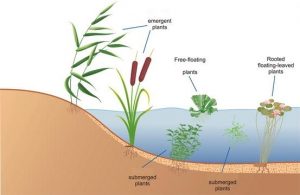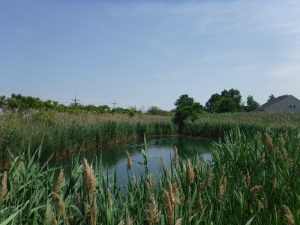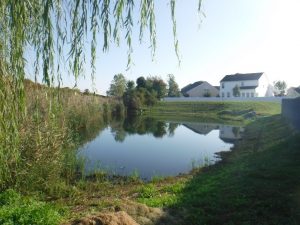
Figure 1: Types of aquatic plants.
The Frog Blog
Aquatic Weed Wednesday
Aquatic Weed Wednesday is upon us once again!
Today, we will take a look at an emergent aquatic plant commonly found around ponds, wetlands, and other water bodies: Common reed (Phragmites australies)
Phragmites australis: pronounced (fræɡˈmaɪˌtiːz /australis/) is known as the common reed or Eurasian reed and is an emergent perennial plant from the Poaceae (grass) family.
In the above figure, the common reed is the plant farthest to the left. Phragmite stem diameter ranges from 0.2 to 0.6 inches and the height usually reaches 10 to 12 feet, with maximum heights reported up to 20 feet tall. The leaves range from 4.0 to 20 inches long and 0.4 to 2.0 inches wide.1 The plant grows aggressively from rhizomes (underground hollow root structures) as well as stolons (above ground horizontal stems). In addition, phragmites reproduce by wind spread seeds. Due to its aggressive nature, the invasive common reed (Phragmites australis) outcompetes the native North America reed (Phragmites australis subsp. americanus). It forms dense stands that reduce light and crowd out native plants. As a result, both diversity and population of plants, waterfowl, and fish in or around a body of water decreases.
So, what does this all mean for your pond? Small stands or patches of phragmites can be beneficial if kept under control. They provide shoreline stabilization and habitat for song birds. However, if not kept in check, they can quickly overtake a water body in just a few years. The stands of phragmites can choke out a pond’s outlets and clog its overflow structures. As a result, the pond may overflow its banks causing property damage and other serious problems.
AQUA DOC offers phragmite spray and removal services to address these issues. Around late summer, early-autumn the plants are sprayed to prevent regrowth after removal in mid to late fall. We use specialized equipment to cut the phragmite stands below the waterline for a professional finish (Shown in Figure 2 & 3). If you are considering our removal services for your pond, contact us for a free removal quote. We look forward to restoring your pond to its natural beauty.
By: Matthew Mayher
AQUA DOC Aquatic Biologist

Before AQUA DOC emergent weed removal service

After AQUA DOC emergent weed removal service
Sources:
1. Gettys, L. A., Haller, W. T., and Petty, D. G. (2014). Best Management Practices Handbook: Third Edition (171-176)
2. USDA. Plant Guide: Common Reed Phragmites australis (Cav.) Trin. ex Steud. <https://plants.usda.gov/plantguide/pdf/pg_phau7.pdf>
3. Favas, P. J. C., et al. (2016). Phytofiltration of Metal(loid)-Contaminated Water: The Potential of Native Aquatic Plants. Phytoremediation: Management of Environmental Contaminants, Volume 3. A. A. Ansari, S. S. Gill, R. Gill, G. R. Lanza and L. Newman. Cham, Springer International Publishing: (311).

